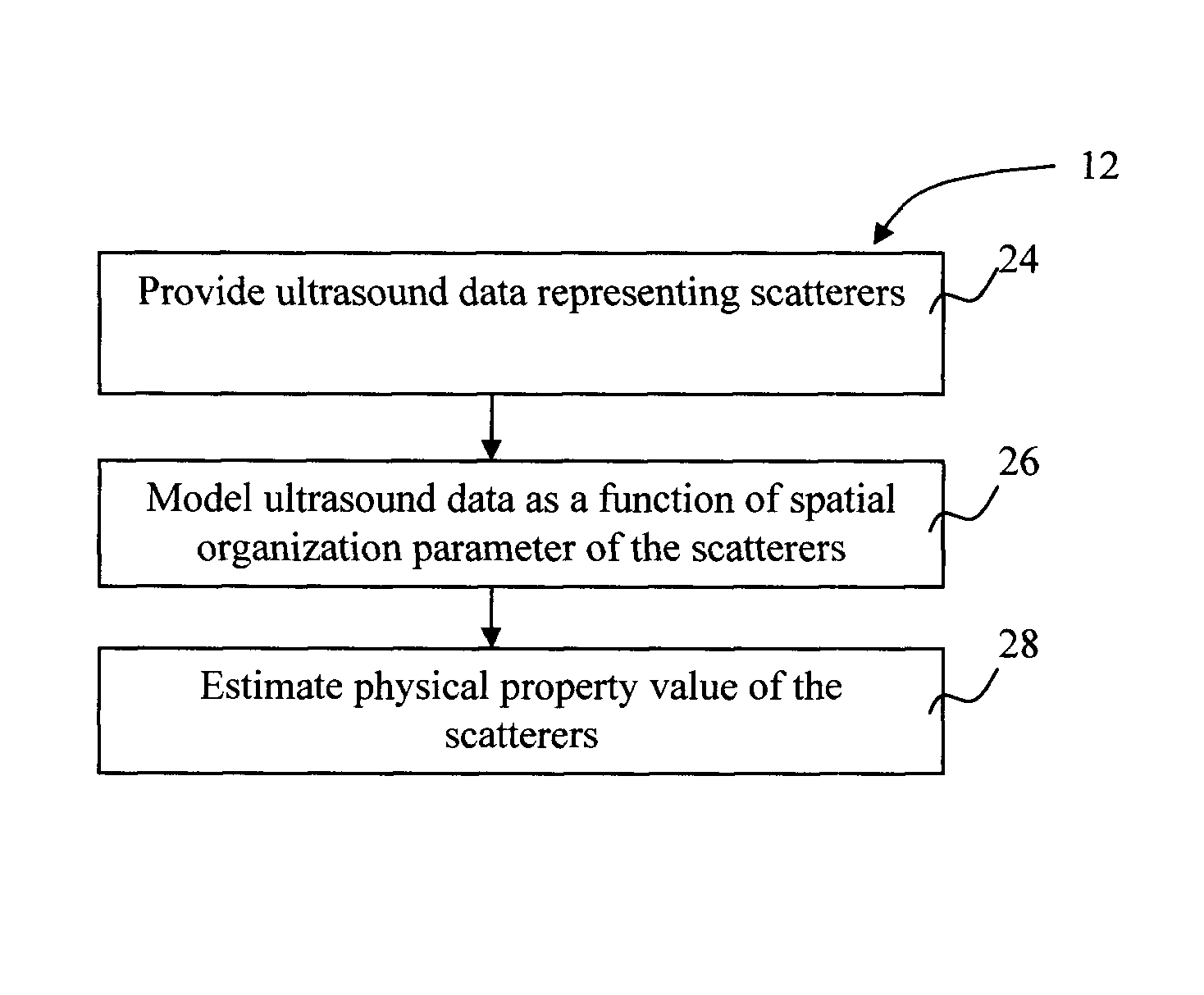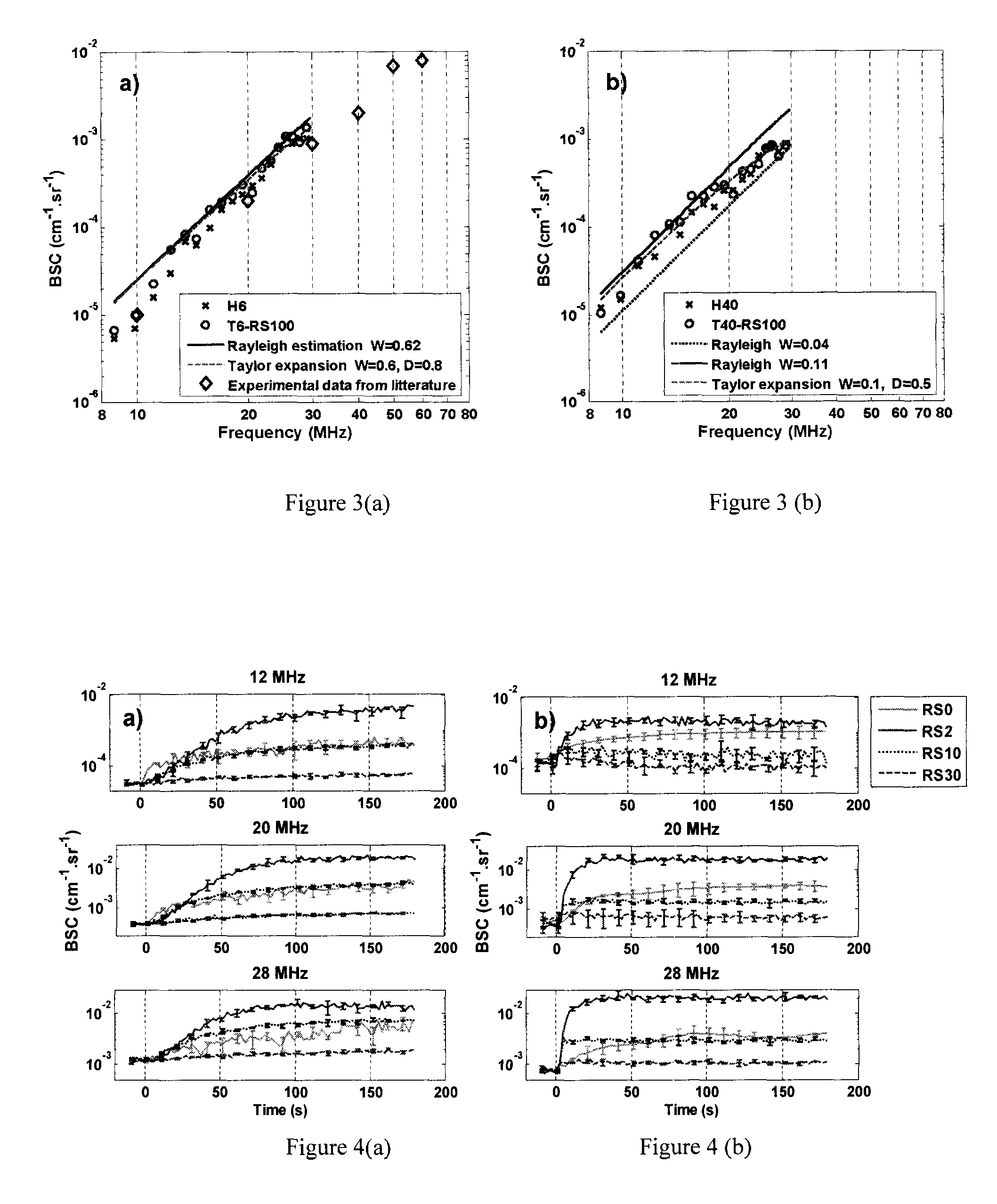Method and system of ultrasound scatterer characterization
a scatterer and ultrasound technology, applied in the field of methods and systems of ultrasound scatterer characterization, can solve the problems of unsuitable methods for all applications, unsuitable for characterizing dense concentrations of scatterers, and risk of strok
- Summary
- Abstract
- Description
- Claims
- Application Information
AI Technical Summary
Benefits of technology
Problems solved by technology
Method used
Image
Examples
example 1
This Example Illustrates a Validation of the First Embodiment of the Method 12
Summary:
[0129]Different samples of whole blood and red blood cell suspensions at 6% and 40% hematocrits were prepared and quantitatively characterized at room temperature using three focused wideband transducers covering the bandwidth from 9 to 30 MHz. According to the first embodiment of the present invention, a second order Taylor approximation of the structure factor was used to achieve data reduction of the BSC measurements, to extract two physical parameters, the packing factor (W) and the mean normalized dimension of isotropic aggregates (D). The D parameter was validated by an optical imaging method at 6% hematocrit under static conditions. Both parameters closely matched theoretical values for non-aggregated red blood cells. This therefore validated the theoretical SFSE model of the present invention.
Blood Preparation:
[0130]Fresh porcine whole blood was anti-coagulated with 3 g / L of ethylene diamin...
example 2
This Example Illustrates In Vivo Results Obtained by the First Embodiment of the Method 12 to Obtain Information about Red Blood Cell Aggregation in a Brachial Vein of a Normal Subject
[0155]A high frequency transducer (Visualsonics, Canada) was used to image the brachial vein of the normal subject's forearm. In this case, the RMV-710 probe was used (25 MHz center frequency, focal length 1.5 cm). The probe was positioned parallel to the vein of interest to provide a longitudinal section view of the vein. Each image contained 384 vertical lines. The equivalent to 10 images of the same section were digitized at a sampling frequency of 500 MHz. A region of interest was delimited around the venous valve. The data was processed as described for the first embodiment of the method 12, except that the power spectra were calculated on windows of 32 points positioned at 10 points intervals, for an overlap of 22 points. This allowed a 2D mapping of W and D over the image. Each estimate of W and...
example 3
This Example Illustrates In Vitro Results Obtained from the Second Embodiment of the Method 12 where Attenuation and the Physical Parameters are Estimated Simultaneously with the SFSAE Model
Blood Preparation:
[0157]Fresh porcine whole blood was obtained from a local slaughter house, centrifuged and the plasma and buffy coat were removed. Two blood samples were then prepared: (i) a H6 reference sample, which was a 6% hematocrit non-aggregating red blood cells resuspended in physiological saline solution; and (ii) a 40% hematocrit T40 test sample, which consisted of red blood cells resuspended in plasma to promote aggregation.
In Vitro Experiment in a Couette Flow System (Couette Device):
[0158]Ultrasound measurements were first performed in a Couette device to produce a linear blood velocity gradient at a given shear rate (FIG. 17). The system consists of a rotating inner cylinder with a diameter of 160 mm surrounded by a fixed concentric cylinder of diameter 164 mm. A 60 mL blood sampl...
PUM
| Property | Measurement | Unit |
|---|---|---|
| frequencies | aaaaa | aaaaa |
| volume | aaaaa | aaaaa |
| frequency | aaaaa | aaaaa |
Abstract
Description
Claims
Application Information
 Login to View More
Login to View More - R&D
- Intellectual Property
- Life Sciences
- Materials
- Tech Scout
- Unparalleled Data Quality
- Higher Quality Content
- 60% Fewer Hallucinations
Browse by: Latest US Patents, China's latest patents, Technical Efficacy Thesaurus, Application Domain, Technology Topic, Popular Technical Reports.
© 2025 PatSnap. All rights reserved.Legal|Privacy policy|Modern Slavery Act Transparency Statement|Sitemap|About US| Contact US: help@patsnap.com



